| How to Use the B&C Measuring System
Courtesy Field & Stream
Developed more than 50 years ago, the Boone and Crockett Club's measuring criteria remains the standard for keeping records of all North American big-game trophies. Because official scoring of a rack requires an intimate knowledge of B&C's extensive rules, we aren't going to teach you to be a panel pro. We can, however, provide a working knowledge of the basics.
Tools Needed to Measure using the Boone & Crockett System
1. 1/4" wide by 6' long flexible steel tape measure with a lip-end
2. 1/4" wide by 6' long flexible steel tape measure with a ring-end
2. Thin, flexible bicycle brake or gear selector type steel cable, three to four feet long
3. Two alligator clips
4. Roll of half-inch wide masking tape
5. Carpenter's folding ruler, with slide end
6. Erasable pencils
7. Copies of the official scoring forms from B&C. Phone Number: 888-840-4868
Six Easy Steps
All measurements should be taken with a quarter-inch flexible steel tape. However, if you think you can get a more accurate measurement with something easier to handle, B&C authorizes using plastic-coated cable (especially helpful for measuring the main beams). Measurements are recorded in inches and eighth-inch fractions. (If a dimension nudges past the 1/16 mark between eighths, round up to the next eighth.) Be sure to keep all right and left antler measurements separate.
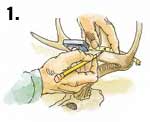 | Establish Baselines: To qualify as measurable, any projection has to meet two requirements: 1) It must be at least one inch long from the tip to its junction with any other antler structure; and 2) at some location along its length (but not within one inch of the tip), the point must be longer than it is wide. So the initial step in measuring whitetail antlers is to establish "baselines" for all possible points and to "qualify" suspect points. Determine point bases by draping the |
quarter-inch tape over the point at its junction with the other antler structure and marking the baseline so that it coincides with the edges of the host beam or point.
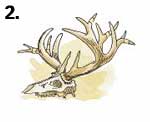 | Identify Non-Typical Points: If an antler point is measurable, it must then be classified as typical or non-typical. All typical points project from the top -- not the sides or bottom -- of the main beam; and they may not branch from other points. The final point count for each antler includes all measurable points -- typical and non-typical -- plus the main beam tips. Look at both sides of the rack and match up points by their location. If extra points along the beam tops create |
obvious mismatches from side to side, these may be non-typical. Missing or broken-off points can also cause mismatches and reduce the final score. Mark all abnormal points on a typical rack with pieces of masking tape. Later, as the points are measured and recorded, the tape can be removed to help keep track of which points have been measured.
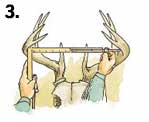 | Inside Spread: The inside spread is the only spread measurement that counts in the final score. Taken with the carpenter's rule between the inside of the main beams at their widest point, this measurement's path must be perpendicular to the center line of the skull and parallel to the top of the skull plate. The inside spread's credit may be equal to, but may not exceed, the longer of the main beam measurements. If it does, the longer beam measurement becomes the spread score. |
The other two spread measurements -- tip-to-tip (B, in Panel No. 6) and greatest spread (C) -- are supplementary data (as is the number of points); they simply add numerical perspective to the overall size and configuration of the rack.
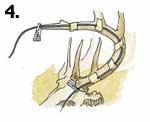 | Beam Length: Measure the main beam from tip to burr by carefully taping the cable along the outside center line of the antler. Use alligator clips to mark the ends of the cable. Then stretch the cable along the tape to record the distance between the clips. If there's a question about which path should be taken on a curving beam (or point, for that matter), measure both sides and record the longer dimension. If bumps, bulges, ridges and other points interfere with the measurement path, take the shortest route around them. |
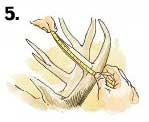 | Points: Next are the point measurements. Using the lip-end tape, measure from the tip of each tine to the baseline pencil marks (made in Step 1). Begin with the first typical point or brow (G-1, in Panel No. 6), and measure each of the typical points on both antlers. Then measure the non-typical points (E). |
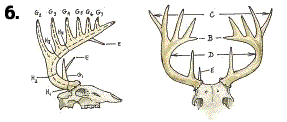 | Circumference: The final dimensions to measure are the circumferences of the main beams. Two standards apply: Circumferences are always read at the narrowest place within the designated locations, and four measurements must be made on each antler. Except for the first circumference, these |
measurements are made at locations along the main beams between the typical points. The first circumference (H-1) is taken at the narrowest place between the antler and burr and the first point or brow tine; the second circumference, H-2, comes between G-1 and G-2; the third, H-3, is between G-2 and G-3; and H-4 is taken between the third and fourth typical points. Use the flexible quarter-inch steel tape for these measurements, not the cable. The latter can slip in between bumps on the beam and cause illegitimately low measurements to be registered.
Final Score
Turning all these figures into a score requires nothing more than simple addition and subtraction, though there are some fractions. Add up the following: inside spread, both main beams, all typical points and all four circumferences from each beam. Compare the corresponding measurements -- beams, points and circumferences -- from the right antler to the left, and subtract the smaller number from the larger. (If G-1 left equals 32/8 and G-1 right equals 35/8, the difference is 3/8.) Add up all these differences (and any non-typical points), and then subtract from the above total. Voila! That is your score.
Before an official measurement can be made, the antlers must air-dry for at least 60 days. The B&C world-record typical whitetail currently scores 2135/8, while a minimum entry score is 170. For bowhunters, the Pope and Young record is 2044/8, with a minimum of 125 to get in the book. For more information on scoring trophies, or to order the 11th Edition of Records of North American Big Game ($49.95) hot off the presses, call the Boone and Crockett Club (888-840-4868).
| |
|